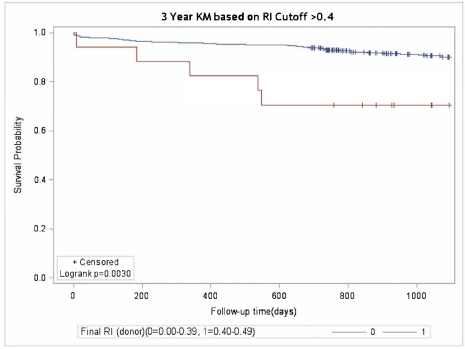Pump Resistive Index Values and Not Preimplantation Kidney Biopsy Predict Kidney Allograft Survival
1Albert Einstein College of Medicine, Bronx, NY
2Department of Surgery, Montefiore Medical Center, Bronx, NY
3Department of Epidemiology and Population Health, Albert Einstein College of Medicine, Bronx, NY.
Meeting: 2018 American Transplant Congress
Abstract number: D118
Keywords: Biopsy, Cadaveric organs, Graft failure, Kidney transplantation
Session Information
Session Name: Poster Session D: Kidney Donor Selection / Management Issues
Session Type: Poster Session
Date: Tuesday, June 5, 2018
Session Time: 6:00pm-7:00pm
 Presentation Time: 6:00pm-7:00pm
Presentation Time: 6:00pm-7:00pm
Location: Hall 4EF
Aim
To investigate the relationship between histological findings of preimplantation kidney biopsies and pump resistive index (RI) values during machine preservation and subsequent allograft survival.
Methods
We retrospectively reviewed all patients who received a kidney-only transplant between Jan 1, 2009, and Dec 31, 2014, at our center and followed-up until Dec 1, 2016. Deaths with functioning allograft were excluded from analysis. We divided obsolete glomerulosclerosis into 3 groups (<10%, 10-20%, >20%), intimal arterial narrowing into 3 groups (<10%, 11-25%, >25%) and RI into 5 groups (0.00-0.09, 0.10-0.19, 0.20-0.29, 0.30-0.39, 0.40-0.49). Log-rank test was used to test for significant differences in survival probability between all groups.
Results
506 patients received deceased donor kidney-only transplants. The median age was 53.6 (range, 21.1-79.2) and 58% male. 57% of deceased donors were standard, 31% ECD and 12% DCD with a median KDPI of 62. During a mean follow-up of 36 months (range, 23-94), 51 patients lost their allografts (death-censored graft survival 90%). There was no difference in terms of patients' age, sex, and race when graft loss patients are compared to those with functioning allograft. The graft loss group had higher KDPI (71 vs. 61, p=0.03) and more ECD (49% vs. 29%, p=0.01). Histological findings on preimplantation biopsies showed no association with short-term allograft failure at 1, 2, and 3 yrs. Different RI categories have significantly different survival experiences in 1, 2, and 3 yrs (p=0.030, p=0.001, p=0.008, respectively). RI >0.4 performed worse than other RI groups as seen in Figure 1 (3 yr KM graft survival).
Conclusion
Percent of obsolete glomerulus and arterial narrowing in preimplantation biopsies did not predict allograft failure, whereas RI >0.4 was a strong independent predictive factor for allograft failure up to 3 years.
CITATION INFORMATION: Liu J., Blumfield A., Trivedi M., Mishra N., Mohammed O., Lin J., Ajaimy M., Graham J., Rocca J., Akalin E., Greenstein S. Pump Resistive Index Values and Not Preimplantation Kidney Biopsy Predict Kidney Allograft Survival Am J Transplant. 2017;17 (suppl 3).
To cite this abstract in AMA style:
Liu J, Blumfield A, Trivedi M, Mishra N, Mohammed O, Lin J, Ajaimy M, Graham J, Rocca J, Akalin E, Greenstein S. Pump Resistive Index Values and Not Preimplantation Kidney Biopsy Predict Kidney Allograft Survival [abstract]. https://atcmeetingabstracts.com/abstract/pump-resistive-index-values-and-not-preimplantation-kidney-biopsy-predict-kidney-allograft-survival/. Accessed December 20, 2025.« Back to 2018 American Transplant Congress

